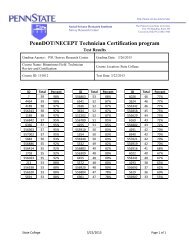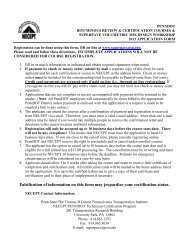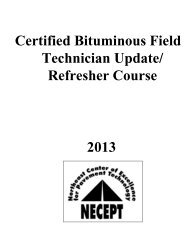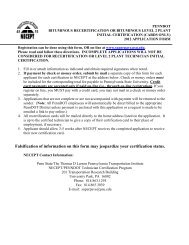HMA Pavement Mix Type Selection Guide - Sines - Superpave
HMA Pavement Mix Type Selection Guide - Sines - Superpave
HMA Pavement Mix Type Selection Guide - Sines - Superpave
You also want an ePaper? Increase the reach of your titles
YUMPU automatically turns print PDFs into web optimized ePapers that Google loves.
<strong>HMA</strong> <strong>Pavement</strong> <strong>Mix</strong> <strong>Type</strong> <strong>Selection</strong> <strong>Guide</strong><br />
Ron <strong>Sines</strong>, P.E.<br />
P.J. Keating Company<br />
October 18 th , 2001
<strong>HMA</strong> <strong>Pavement</strong> <strong>Mix</strong> <strong>Type</strong> <strong>Selection</strong> <strong>Guide</strong><br />
Manual Purpose<br />
Provide designers with a method for selecting<br />
appropriate mix types considering factors such as:<br />
Existing pavement condition and necessary preparation<br />
Subsurface <strong>Pavement</strong> structures<br />
Environment<br />
Traffic<br />
Economy<br />
Manual developed by cooperative effort of the FHWA<br />
and NAPA<br />
Brown, Epps, Garcia, Gulden, Hansen, Harrington, Michael,<br />
Page, Petros, Scofield, <strong>Sines</strong>, Weigel
<strong>HMA</strong> <strong>Pavement</strong> <strong>Mix</strong> <strong>Type</strong> <strong>Selection</strong> <strong>Guide</strong><br />
Intended Audience<br />
Consultant Engineers<br />
Architects<br />
New hires<br />
State Agencies and Industry<br />
Provides a base line to begin from whether your<br />
in CT, ME, NH, NJ, NY, PA, or RI<br />
Information presented today will be familiar to<br />
many of us so please bear with me
<strong>HMA</strong> <strong>Pavement</strong> <strong>Mix</strong> <strong>Type</strong> <strong>Selection</strong> <strong>Guide</strong><br />
What's in the <strong>Selection</strong> <strong>Guide</strong>?<br />
Standard definitions<br />
<strong>Pavement</strong> Layers and traffic<br />
General recommendations for surface preparation<br />
Discussion of mix types covered by the manual<br />
Dense Graded, SMA, and OGFC<br />
Decision tree for mix type selection
<strong>HMA</strong> <strong>Pavement</strong> <strong>Mix</strong> <strong>Type</strong> <strong>Selection</strong> <strong>Guide</strong><br />
Dense Graded <strong>Mix</strong>es<br />
Considered the <strong>HMA</strong> workhorse since they may be used<br />
effectively in all pavement layers and for all traffic<br />
conditions<br />
Can be used for structural and functional overlays, for<br />
leveling and patching, and to provide pavement friction<br />
Defined by their Nominal Maximum Aggregate Size<br />
Defined by relative coarseness of the specific mix<br />
Table 2 – Definition of Fine- and Coarse Dense Graded <strong>Mix</strong>tures
<strong>HMA</strong> <strong>Pavement</strong> <strong>Mix</strong> <strong>Type</strong> <strong>Selection</strong> <strong>Guide</strong><br />
Dense Graded <strong>Mix</strong>es<br />
Table 2: Definition of Fine- and Coarse Dense-graded <strong>Mix</strong>tures<br />
<strong>Mix</strong>ture NMAS<br />
37.5 mm (1 1/2”)<br />
25.0 mm (1”)<br />
19.0 mm (3/4”)<br />
12.5 mm (1/2”)<br />
9.5 mm (3/8”)<br />
Coarse-Graded<br />
45 % Passing 2.36 mm Sieve
<strong>HMA</strong> <strong>Pavement</strong> <strong>Mix</strong> <strong>Type</strong> <strong>Selection</strong> <strong>Guide</strong><br />
Dense Graded <strong>Mix</strong>es – ETG Proposed Definitions<br />
AASHTO MP2 Table 4 – Gradation Classification<br />
Nominal Max<br />
Aggregate Size<br />
Primary Control<br />
Sieve<br />
PCS Control Point<br />
37.5 mm<br />
9.5 mm<br />
47<br />
25.0 mm<br />
4.75 mm<br />
40<br />
19.0 mm<br />
4.75 mm<br />
47<br />
12.5 mm<br />
2.36 mm<br />
39<br />
9.5 mm<br />
2.36 mm<br />
47
<strong>HMA</strong> <strong>Pavement</strong> <strong>Mix</strong> <strong>Type</strong> <strong>Selection</strong> <strong>Guide</strong><br />
Dense Graded <strong>Mix</strong>es<br />
Percentage Passing<br />
100<br />
90<br />
80<br />
70<br />
60<br />
50<br />
40<br />
30<br />
20<br />
10<br />
0<br />
0.075 0.600 1.18 2.36 4.75<br />
9.5 12.5 19.0 25.0<br />
37.5<br />
US Standard Sieve Series<br />
50.0
<strong>HMA</strong> <strong>Pavement</strong> <strong>Mix</strong> <strong>Type</strong> <strong>Selection</strong> <strong>Guide</strong><br />
Advantages of Fine- and Coarse Dense Graded <strong>Mix</strong>es<br />
Fine-Graded <strong>Mix</strong>es<br />
Lower permeability<br />
Improved workability (< 25 mm (1”) NMAS)<br />
Thinner lifts<br />
Greater durability for low volume roads<br />
Smooth texture<br />
Coarse-Graded<br />
Allows thicker lifts to be placed<br />
Increased macro texture<br />
Economy
<strong>HMA</strong> <strong>Pavement</strong> <strong>Mix</strong> <strong>Type</strong> <strong>Selection</strong> <strong>Guide</strong><br />
Stone Matrix Asphalt <strong>Mix</strong>es<br />
Gap-graded <strong>HMA</strong> which maximizes rutting resistance<br />
and durability<br />
Stable stone on stone skeleton held together by a rich<br />
mixture of PGB, filler, and stabilizing agent<br />
Used almost exclusively for surface courses on high<br />
volume interstate and US highways<br />
Can be considered as an intermediate layer in cases<br />
where heavy slow moving vehicles use the pavement
<strong>HMA</strong> <strong>Pavement</strong> <strong>Mix</strong> <strong>Type</strong> <strong>Selection</strong> <strong>Guide</strong><br />
Open Graded Friction Course <strong>Mix</strong>es<br />
Designed to be permeable to water to reduce the<br />
potential for hydroplaning, and splash and spray<br />
Use of modified asphalts and/or fibers is highly<br />
recommended to increase the amount of binder in the<br />
mix improving their durability and performance<br />
Should only be used on medium to high volume<br />
roadways with high posted speeds<br />
Asphalt treated permeable base is used below dense<br />
graded or SMA mixes as a drainage layer
<strong>HMA</strong> <strong>Pavement</strong> <strong>Mix</strong> <strong>Type</strong> <strong>Selection</strong> <strong>Guide</strong><br />
Recommended General <strong>Mix</strong> <strong>Type</strong>s for Surface,<br />
Intermediate, and Base Courses – Figure 2
<strong>HMA</strong> <strong>Pavement</strong> <strong>Mix</strong> <strong>Type</strong> <strong>Selection</strong> <strong>Guide</strong><br />
Recommended General <strong>Mix</strong> <strong>Type</strong>s for Surface,<br />
Intermediate, and Base Courses – Figure 2
<strong>HMA</strong> <strong>Pavement</strong> <strong>Mix</strong> <strong>Type</strong> <strong>Selection</strong> <strong>Guide</strong><br />
Recommended <strong>Mix</strong> <strong>Type</strong>s for Surface, Intermediate, and<br />
Base Courses – Figure 3
<strong>HMA</strong> <strong>Pavement</strong> <strong>Mix</strong> <strong>Type</strong> <strong>Selection</strong> <strong>Guide</strong><br />
Recommended <strong>Mix</strong> <strong>Type</strong>s for Surface, Intermediate, and<br />
Base Courses – Figure 3
<strong>HMA</strong> <strong>Pavement</strong> <strong>Mix</strong> <strong>Type</strong> <strong>Selection</strong> <strong>Guide</strong><br />
Determining Appropriate <strong>Mix</strong> <strong>Type</strong> Decision Tree<br />
Determine the total thickness of <strong>HMA</strong> required<br />
New construction – structural design<br />
Rehabilitation – pavement and structural design<br />
evaluation<br />
Determine the type of mixture appropriate for the<br />
surface coarse based on traffic and cost<br />
Determine the proper aggregate size to use for the mix<br />
<strong>Pavement</strong> loading the main concern
<strong>HMA</strong> <strong>Pavement</strong> <strong>Mix</strong> <strong>Type</strong> <strong>Selection</strong> <strong>Guide</strong><br />
Determining Appropriate <strong>Mix</strong> <strong>Type</strong> Decision Tree<br />
Continued ..<br />
Consider appearance<br />
Larger NMAS mixes will have coarse texture and may not be<br />
appropriate for all applications<br />
Consider traffic flow through the work zone<br />
When lane drop-offs are allowed smaller NMAS mixes may be<br />
preferred for safety<br />
Consider construction phasing<br />
Will an underlying layer be exposed to traffic for extended time or<br />
over the winter? If yes, a smaller NMAS mix may be preferred<br />
Never compromise on performance when<br />
selecting a mix type.
<strong>HMA</strong> <strong>Pavement</strong> <strong>Mix</strong> <strong>Type</strong> <strong>Selection</strong> <strong>Guide</strong><br />
Determining Appropriate <strong>Mix</strong> <strong>Type</strong> Decision Tree<br />
Subtract the thickness of the surface course from<br />
the total thickness<br />
Repeat steps 2 and 3 for the remaining lifts<br />
Example Problem
<strong>HMA</strong> <strong>Pavement</strong> <strong>Mix</strong> <strong>Type</strong> <strong>Selection</strong> <strong>Guide</strong><br />
Decision Tree Example Problem<br />
Given: A structural evaluation for a 20 km new<br />
pavement on a high volume, urban highway with heavy<br />
truck traffic requires a total thickness of 300 mm (12”) of<br />
<strong>HMA</strong>, sections of pavement will be open to traffic<br />
following completion of intermediate course<br />
Solution:<br />
Step 1 Determine total thickness<br />
Provided as a given<br />
Step 2 Determine type of mix for surface course<br />
Proper aggregate size considering loading<br />
Consider appearance<br />
Consider traffic flow<br />
Consider construction phasing
<strong>HMA</strong> <strong>Pavement</strong> <strong>Mix</strong> <strong>Type</strong> <strong>Selection</strong> <strong>Guide</strong><br />
Recommended <strong>Mix</strong> <strong>Type</strong>s for Surface, Intermediate, and<br />
Base Courses – Figure 3
<strong>HMA</strong> <strong>Pavement</strong> <strong>Mix</strong> <strong>Type</strong> <strong>Selection</strong> <strong>Guide</strong><br />
Decision Tree Example Problem - Continued<br />
Based on Figure 3 either SMA, OGFC, or Dense Coarse Graded <strong>Mix</strong><br />
would be appropriate<br />
• Select 12.5 mm DCG mix for surface at 50 mm<br />
Step 3 Subtract surface lift from total section required<br />
Total remaining <strong>HMA</strong> for intermediate and base course 250 mm<br />
Step 4 Repeat steps 2 and 3 until complete<br />
Proper aggregate size considering loading<br />
Consider appearance<br />
Consider traffic flow<br />
Consider construction phasing
<strong>HMA</strong> <strong>Pavement</strong> <strong>Mix</strong> <strong>Type</strong> <strong>Selection</strong> <strong>Guide</strong><br />
Decision Tree Example Problem - Continued<br />
Based on Figure 3 either Dense Fine Graded, SMA, or<br />
Dense Coarse Graded <strong>Mix</strong> would be appropriate<br />
• Select 2 lifts of 19 mm DCG mix for intermediate course at 75 mm<br />
Subtract intermediate lifts from remain <strong>HMA</strong> required<br />
Total remaining <strong>HMA</strong> for base course is 100 mm<br />
Step 4 Repeat steps 2 and 3 until complete<br />
Proper aggregate size considering loading<br />
Consider appearance<br />
Consider traffic flow<br />
Consider construction phasing
<strong>HMA</strong> <strong>Pavement</strong> <strong>Mix</strong> <strong>Type</strong> <strong>Selection</strong> <strong>Guide</strong><br />
Decision Tree Example Problem - Continued<br />
Based on Figure 3 either Dense Fine Graded or Dense<br />
Coarse Graded <strong>Mix</strong> would be appropriate<br />
• Select 1 lift of 37.5 mm DCG mix for the base course at 100 mm<br />
This represents only one possible solution to the<br />
problem given<br />
Remember<br />
Not all mixes may be available in your location<br />
When using OGCF it does not count as part of the<br />
structural layer
<strong>HMA</strong> <strong>Pavement</strong> <strong>Mix</strong> <strong>Type</strong> <strong>Selection</strong> <strong>Guide</strong><br />
Summary<br />
<strong>Guide</strong> is intended to provide a rationale method<br />
for mix selection and to specify lift thickness<br />
<strong>Guide</strong> provides a good basic foundation of<br />
information for those not familiar with <strong>HMA</strong><br />
terminology to work from<br />
<strong>Guide</strong> provides strategy for maximizing the<br />
effectiveness of Dense Graded, SMA, and<br />
OGFC mixes<br />
<strong>Guide</strong> is not intended to address every situation
<strong>HMA</strong> <strong>Pavement</strong> <strong>Mix</strong> <strong>Type</strong> <strong>Selection</strong> <strong>Guide</strong><br />
Where to Obtain Your Copy<br />
National Asphalt <strong>Pavement</strong><br />
Association<br />
5100 Forbes Blvd.<br />
Lanham, Maryland 20706-4413<br />
www.hotmix.org<br />
Napa@hotmix.org<br />
1-888-468-6499<br />
Information Series 128










![NEAUPGA Meeting Shingles Presentation Ron Sines.ppt [Read-Only]](https://img.yumpu.com/26919609/1/190x146/neaupga-meeting-shingles-presentation-ron-sinesppt-read-only.jpg?quality=85)

